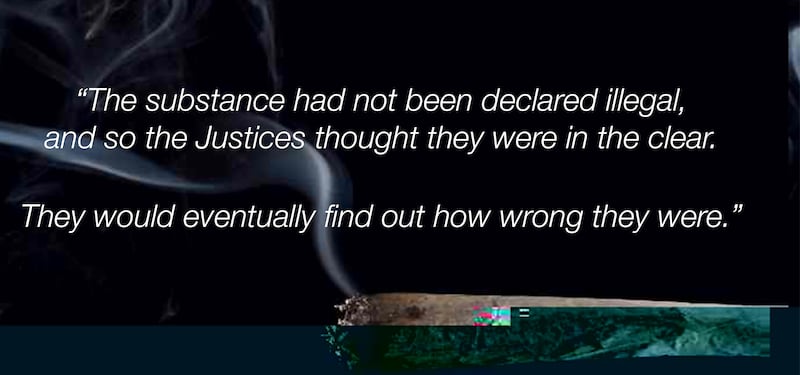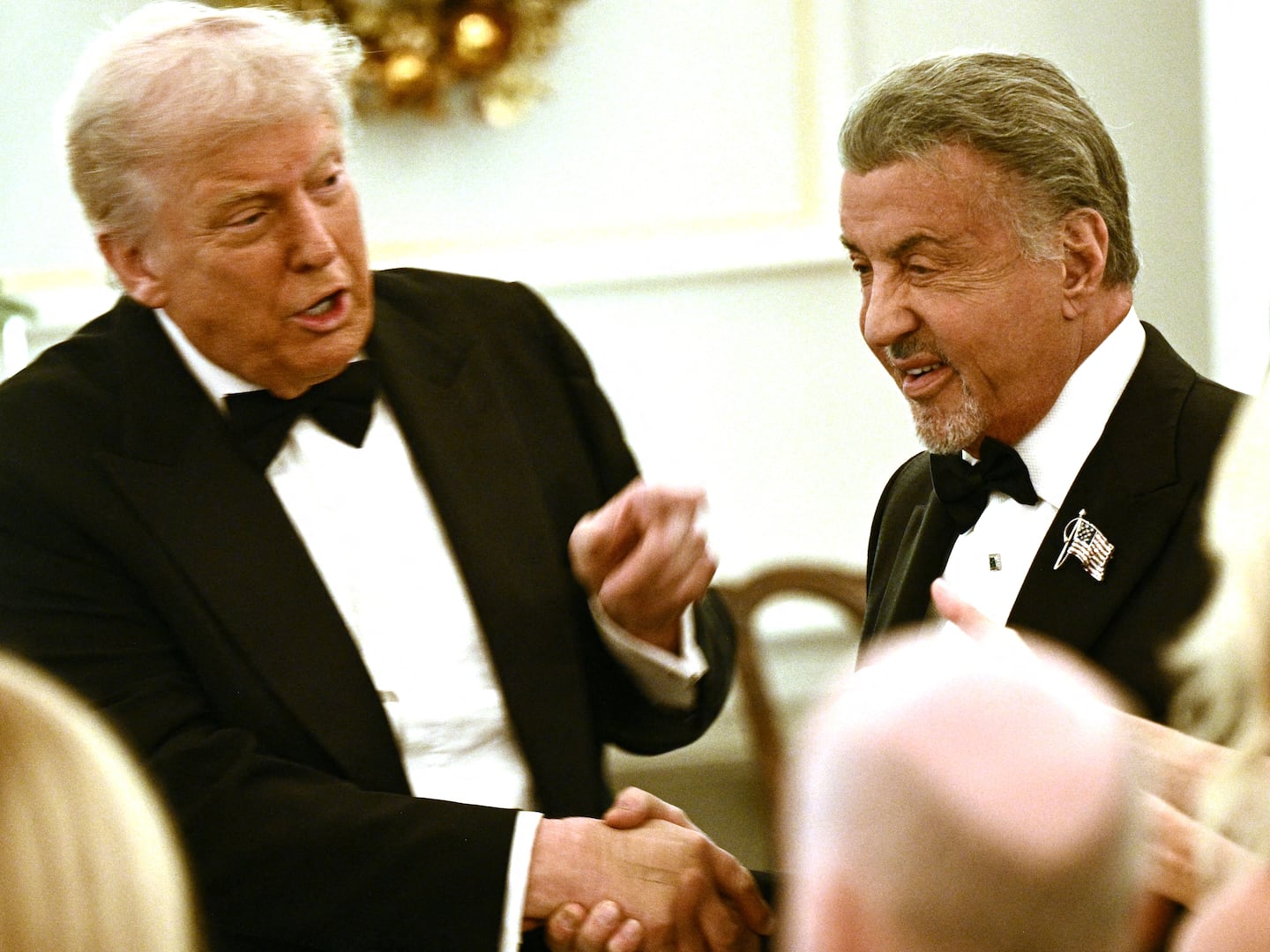On a September day in 2010, Chris Newman drove to Saint Albans, West Virginia, for the grand opening of Secret Pleasures, a store specializing in sex toys, tobacco products, and smoking accessories. The owner, Kenneth Holliday, who ran two similar stores in the nearby towns of Huntington and Princeton, had invited a DJ from the local radio station, WKLC Rock 105, to publicize the event. He had also organized a cookout on the sidewalk, where visitors milled about, helping themselves to hot dogs and burgers being grilled by Holliday and his staff. The D.J. walked around inside the store to hype the wares—in particular, one product that had become a big seller at other Secret Pleasures locations: herbal incense.
Newman, 39, a chubby man with a gruff voice and friendly manner, was the wholesale marketer of Wildfire, a brand of herbal incense manufactured by Newman’s partners at a warehouse in Ironton, Ohio. Newman had been supplying the product to Secret Pleasures since March, and for the opening of the Saint Albans store, he had brought along a new, orange flavor that Wildfire had just launched. The owner gave away free samples of it to interested customers, confident that they would be back for more.
That’s because Wildfire wasn’t incense. It was synthetic marijuana—dry plant matter sprayed with a chemical, JWH-018, that had psychoactive properties similar to tetrahydrocannabinol, the high-inducing compound in weed. The makers of Wildfire – a former real estate appraiser named Ralph Justice and his two sons, Adam and Eric – purchased the cannabinoid in bulk from a chemical vendor in California, who in turn got the chemicals from China. At the Ironton warehouse, they poured a blend of herbs into an electric cement mixer, and sprayed the JWH-018, dissolved in alcohol, onto the blend as it tumbled inside. A couple of drags of Wildfire were more potent than smoking a whole joint of natural weed. “It hit you a lot quicker,” Eric Justice told me, admitting that he was “stoned all the time” at the warehouse.
For the Justices and for Newman, the most attractive thing about synthetic pot was that it wasn’t an illicit substance in West Virginia and Ohio, two of the states where they were selling their product. But the men knew that both the states were thinking about banning synthetic cannabinoids, just as Kentucky and a few other states had already done.

Visiting Internet forums and chat rooms, Adam Justice began searching for other chemicals that could be sold as highs. There were dozens of synthetic drugs to choose from, most of them compounds like JWH that enterprising chemists and pharmacists had dug up from the scientific literature. The Justices eventually settled on mephedrone, a cocaine-like stimulant that had become wildly popular in the United Kingdom through the late 2000s. Shortly after the opening of Secret Pleasures, Newman began supplying a new product to the store: crushed crystals of mephedrone packaged as “Ivory Bath Salts,” and labelled “Not for Human Consumption.” The Justices were sourcing the chemical from a manufacturer in a dusty industrial town in India at $1500 a kilo, and wholesaling it for $60,000. The substance - though banned in the U.K. -- had not been declared illegal in the United States, and so the Justices thought they were in the clear. They would eventually find out how wrong they were.
Synthetic drugs have been sold at the margins of the law for decades. Back in the early 80s doctors in San Francisco and elsewhere encountered young men exhibiting the mannequin-like frozenness seen in Parkinson’s disease patient. The immobility, it turned out, was the result of injecting a synthetic drug created to mimic heroin.
Frustrated by the government’s inability to prosecute the makers of these and other alternatives to heroin, Congress passed the Federal Analogue Act of 1986. Previously, the DEA’s only way of banning a drug was to add it—after it had hit the market—to the government’s list of controlled substances. Under the Analogue Act, substances that were “substantially similar” in chemical structure and pharmacological effect to a prohibited drug were deemed prohibited as well. Instead of having to react to a new psychoactive substance, usually well after it had become popular, the government was now in a position to pre-empt the next high-inducing compound—in other words, kill the buzz before it took effect.
Over the next decade and a half, the problem of synthetic drugs appeared to recede in the United States, with only a handful of new substances emerging on law enforcement’s radar. In early 2000, however, with the rise of internet commerce, a number of websites began selling synthetic drugs marked as “research chemicals.” The intent was to dodge the Analogue Act, under which the prosecution had to establish that the chemical was being sold for human consumption. By the late 2000s, the United States was experiencing what can in hindsight be described as the beginning of a synthetic drug epidemic. First came synthetic cannabinoids, disguised as herbal incense, then synthetic cathinones like mephedrone, packaged as bath salts, all sold openly at smoke shops, gas stations, convenience stores, and even shopping malls. The notion that the substances were unambiguously legal fed on itself: the more widely they were sold, the more acceptable it became for yet other stores to carry them. Professing ignorance of the fact that buyers were smoking or ingesting these products, sellers felt, was enough of a legal cover.
By the time the Justices were getting into the mephedrone game, the DEA was cracking down on synthetic pot throughout the country. In March 2011, the federal agency temporarily added five synthetic cannabinoids, including JWH-18 and JWH-081, to Schedule 1—to the government’s list of substances that are deemed to have no medical use and high potential for abuse. The agency took the same step for three cathinones in October that year; the bans on these substances, as well as a handful of other compounds, were made permanent the following year through a combination of administrative measures and the Synthetic Drug Abuse Prevention Act, signed into effect on July 9, 2012. The federal actions reinforced what several states had already done.
The banning of the five cannabinoids drew protests from the Retail Compliance Association, an industry group formed to lobby on behalf of stores selling herbal incense. “I’d like to ask the government, what is wrong with euphoria and who gave them the right to regulate it?” Daniel Francis, the association’s director, said in an interview to 20/20, aired in June 2011. He likened the pleasurable effects of the products made illicit by the ban to “when you bite into a peanut butter and jelly sandwich and you have that sensation of, ‘Man that’s good.’”
A new generation of synthetic drugs promptly replaced those that had been outlawed. After the JWH chemicals were scheduled in early 2011, another cannabinoid named AM 2201 surfaced. When AM 2201, too, was banned the following year, yet another set of cannabinoids – UR-144 and a derivative, XLR-11 – came to market. A similar cat-and-mouse game bedeviled the government’s efforts to control cathinones. Mephedrone, for instance, was supplanted in the market by 4-MEC or 4-methy-N-ethylcathinone, which is chemically similar to mephedrone except for the existence of an ethyl rather than methyl group at one end of the molecule.
The explosion of synthetic drugs was driven not just by easy access to this pre-existing treasure chest of psychoactive substances, but also by the growth of the internet and globalization. You could share a “trip report” for a new drug through anonymous forums, and distributors like the Justices could use those same forums to find potential new products. Then, when they needed to buy in bulk, suppliers in China and India was just an email away.
*

In November 2014, I traveled to the Indian city of Sangli, home to the factory that supplied mephedrone to the Justices in Ironton. Situated 230 miles southeast of Mumbai, in the middle of turmeric and sugarcane plantations, Sangli is an important center of commerce and industry in the region, somewhere between a small rural town and a large metropolis, with a prominent engineering school, a medical college and a newly unveiled Volkswagen dealership. Yet, aside from a couple of major thoroughfares, Sangli’s streets are narrow and potholed, giving the impression of a village in perpetual transition.
At the northeastern edge of Sangli, shanties and mud houses give way to an industrial suburb. It’s home to a few dozen factories, most of them modest in size, built on lots smaller than a high school gymnasium. The products they manufacture run the gamut from plastics and electrical hardware to textiles and caramel candy. At a far end of the suburb, a stone’s throw from farm country, stands Kamud Drugs Private Limited. Until recently, the factory was run by a young chemical engineer named Abhijit Konduskar.
Konduskar, the scion of a wealthy family, is a lanky young man with a lean face and bulbous eyes. After going to Ohio State to pursue his twin passions of sharpshooting and chemical engineering, he returned to Kolhapur and took charge of Kamud Drugs. At the time he was just 22, fiercely ambitious, and smarting from his failure to qualify as an Olympic shooter. This combination made him determined to make the factory a success.
“He was dynamic, and he had a high IQ,” according to Ravindra Konduskar, a relative who ran the factory until Abhijit took over. “He spent his entire time working on the business.”
In 2005, Kamud obtained a government license to manufacture ketamine, just as two of the region’s biggest producers of the drug were shut down. Ketamine is a fast-acting drug that cuts off the brain from the senses, temporarily isolating it from pain. It was once widely used for treating battlefield injuries.
However, not long after being approved for human use in 1970, the drug fell out of favor with medical doctors because patients anesthetized with it reported hallucinogenic effects when they came to after surgery: some experienced themselves as floating in the air, detached from their senses; some saw psychedelic colors.
The very same effects made ketamine popular as a recreational drug. Since the 80s, ketamine has had a dual life. Veterinarians use the drug to tranquilize cats, horses, and other animals. Others snort, swallow or inject ketamine to get high, which has created a large global illicit market for the drug. Ketamine has time and again been implicated in date rapes – an unsurprising consequence of the drug’s disorienting effects – and has been on the U.S. government’s list of controlled substances since 1999.
Kamud’s entry into ketamine production couldn’t have been better timed. Not long after the factory began manufacturing the anesthetic, two of the region’s biggest ketamine makers were stripped of their license to produce it. “Their entire business came to Kamud,” Ravindra told me.
Sometime in 2009, an Indian man who had previously purchased bulk pharmaceutical ingredients from Kamud contacted the factory with an order for mephedrone, which Kamud’s chemists had no trouble synthesizing. Konduskar soon discovered the high demand for the drug in the U.K. and elsewhere, and by the end of 2009, Kamud had begun manufacturing it for export.
According to Indian investigators, Konduskar asked his international marketing manager, Vaibhav Karkare, to find buyers for mephedrone. After Karkare read about mephedrone on the internet and expressed some reservations about marketing it, Konduskar assured him that the compound wasn’t banned in India or anyplace else. Even so, he instructed Karkare to set up an email address under the name Dave Thomas to correspond with prospective buyers.
By November 2010, the factory had shipped hundreds of kilograms of mephedrone overseas, including packages to the Justices in Ironton, Ohio. The exports were made with “proper documentation” submitted to Indian customs, truthfully declaring the name of the chemical, Balasaheb Shetty, who worked as Kamud’s dispatch manager, told me. There were no questions asked.
*
After the DEA announced in November 2010 that it would control five synthetic cannabinoids, Newman’s partners arranged to ship all of the JWH-018 they had in stock to a buyer in Trinidad and Tobago. Their business was now centered entirely on mephedrone, which the DEA had yet to designate as a controlled substance.
In early December, Ralph Justice told Newman that he wanted to have the next package of mephedrone shipped to Newman’s house in Kentucky. (The earlier packages from Kamud had been sent to the Ironton warehouse.) Justice showed Newman the empty boxes to prove that those shipments had made it through customs without incident; hence, there was nothing illegal or risky about receiving a package of mephedrone from overseas. Newman’s understanding was that Justice didn’t want to draw attention to exactly how much of the chemical the business was selling.
The package, sent from Sangli by DHL, arrived at the courier service’s hub in Erlanger, Kentucky, on December 9. There it drew the attention of a Customs and Border Patrol agent, who decided to check what was inside. Opening the package, the agent found a plastic bag containing an off-white crystalline powder. He scooped out a tiny bit of it and poured it into a drug testing kit. The preliminary result indicated that it was either meth or ecstasy; after the powder was sent to a lab, agents learned that its chemical identity was exactly what the sender had written on the air bill: “4-methylmethcathinone hydrochloride,” or mephedrone.
The Customs and Border Patrol shared the lab report with the DEA, which asked an agent in its Lexington office, James England, to investigate. England and other DEA agents had begun hearing about the growing abuse of mephedrone, and after consulting with DEA chemists, England gathered that mephedrone, while not listed as a controlled substance, could be treated as an illicit drug. Although the government had not yet proved in a court that mephedrone was chemically and pharmacologically similar to methcathinone, the July advisory was in effect a public announcement that the substance belonged in a gray zone.

Newman knew none of this—he just knew the package was late—when a UPS truck dropped off the shipment on December 21. “Merry Christmas,” the deliveryman said.
Newman went inside and picked up the phone to let Ralph Justice know that the package had finally arrived. The landline was dead, and Newman’s cell phone didn’t get reception where he lived, so Newman put the package in the trunk of his car and set out for Ironton. When he’d driven about a mile, Newman was pulled over by an officer from the Kentucky state police. DEA agents, including Jim England, arrived shortly after and took Newman back to his house.
There must have been a mistake, Newman told them, because the product he had been selling wasn’t illegal. It even had its own legitimately registered trademark, he argued. Newman was forthcoming about the details of the Ironton warehouse. He told the agents that although the product was labelled “not for human consumption,” he knew that buyers were taking it.
Newman didn’t think much of making that admission, but it gave the investigators the leverage to eventually charge him under the Analogue Act.
It didn’t take the authorities too long to round up the rest of the group. On January 6, federal agents made a “controlled delivery” of a shipment of mephedrone bound for the Ironton warehouse, and arrested Ralph Justice after he took possession of it. Searching the warehouse, agents found in a safe a bag of white powder labelled “naphyrone,” another synthetic cathinone that the Justices were preparing to market in case mephedrone ended up on the DEA’s list of controlled substances.
Tipped off to his father’s arrest, Adam Justice fled to San Antonio, Texas where he was arrested a few weeks later. In February, 2011, the three Justices—along with Newman—were indicted in federal court on charges of importing and distributing a controlled substance analogue. After they pleaded guilty, they were given prison terms ranging from 20 to 54 months. Ralph Justice died of cancer in prison. The other three men have finished serving their sentences.
The other end of the supply chain met a similar fate. In 2011, after the Indian government listed ketamine as a controlled substance because of reports about its use as a narcotic, Indian investigators discovered that Konduskar had been diverting hundreds of kilograms of the chemical from his factory and shipping it overseas in violation of customs rules, hiding it in boxes of oats, detergent and tea. India’s Directorate of Revenue Intelligence (DRI), which monitors the flow of goods in and out of the country, seized over 800 kilograms of ketamine that had been diverted from Kamud, and arrested Konduskar from his penthouse apartment in a Mumbai high-rise, sealing the property and confiscating his BMW. Konduskar and three of his employees was charged under India’s Narcotic Drugs and Psychotropic Substances Act. But in August, he and the others were granted bail on a technicality.
Returning to Kolhapur, Konduskar struggled to pay his staff at Kamud Drugs. Kamud’s license to manufacture ketamine had been cancelled, and the company couldn’t export its stock of mephedrone to the U.S., as the DEA had finally banned it in October 2011. The gray zone had been erased.
Konduskar attempted to sell the mephedrone to buyers in the U.K. through underground back channels, but when the shipment of drugs was in a cargo complex at the Ahmedabad airport DRI agents discovered a bag of powder printed with Kamud Drugs’ name and address. Lab analysis of the 43 packets inside the bag found that six contained ketamine and the rest were methamphetamine.
That December, the DRI arrested Konduskar and charged him with manufacturing methamphetamine. He insisted that Kamud had only manufactured mephedrone, which could easily be mistaken for meth because of the similarities in molecular structure. The irony of the lab’s alleged mis-identification couldn’t have escaped him. Until this point, the subtle chemical difference between mephedrone and methamphetamine had provided him a safe legal harbor. Now, that fine line between licit and illicit had apparently been blurred by a crude chemical test.
On a visit to India three years after Konduskar's arrest, I walked up the paan-stained stairway of a courthouse in Ahmedabad and peered into a room on the second floor where a judge was to conduct a trial hearing in the DRI’s case against Konduskar. I spotted Konduskar sitting by the door, dressed in a gray, long-sleeved shirt, dark trousers, and pointy, black shoes. He looked like he was ready for a corporate board meeting, except that he hadn’t shaved in days, which he later explained was because inmates at the Sabarmati prison—where he’d spent the past three years—were allowed to shave only on Fridays.
He told me his lawyers had appealed for re-testing of the confiscated material at a different lab, which he was confident would prove the methamphetamine charge to be false. I asked him why Kamud had been manufacturing mephedrone, which was also a known narcotic. He claimed he’d always thought the compound was a pharmaceutical intermediate. “When you work in contract research and manufacturing, you don’t know what an intermediate is going to be used for,” he said. “So when people ask you to make a certain molecule, you don’t ask questions.
“So if you ask me today, did you know what mephedrone is used for, I’ll say, it is just a chemical to me. I sold it as a chemical.” He spoke earnestly, searching my face to see if I was being persuaded. “I never made mephedrone for human consumption.”
*
Not long ago, a 16-year-old boy at a high school in Worcester, Massachusetts, had to be taken to the emergency room after a severe bout of vomiting and nausea. His heart was beating unusually fast, at 160 beats per minute. Doctors learned that he had been “vaping” a liquid incense called “Bizarro”—a synthetic cannabinoid formulation. Using vape pens in the back of the classroom to inhale synthetic drugs was apparently in vogue; in the words of a classmate, “the teacher thinks you just have a pen in your mouth.” According to a report prepared for the National Institute of Drug Abuse Early Warning System Network, the boy told doctors: “That’s what we do nowadays to make class more fun.”
Although the DEA has cracked down on distributors of synthetic drugs in the U.S., seizing hundreds of kilograms of cannabinoids, cathinones and other classes of drugs from smoke shops and warehouses every year, their supply into the U.S. from overseas continues unabated. Despite several prosecutions under the Analogue Act over the last few years, distributors continue to push out new products containing chemicals whose legal status is for them a matter of happy ambiguity. If the government’s hope was that the fuzziness of the Analogue Act would inspire players in the business to become risk-averse and avoid the gray zone, the opposite has happened. Those in the trade appear to have taken the optimistic stance that anything not explicitly controlled is worth a shot.
Manufacturers in China, unquestionably the biggest producer of these chemicals, as well as in other countries are thriving. I found dozens of India-based suppliers of synthetic drugs on IndiaMART, which bills itself as the country’s largest business-to-business online marketplace. On its site, buyers can connect with suppliers of millions of products, from automobile parts to jewelry. I searched for sellers of mephedrone and various other cathinones, as well as synthetic cannabinoids like JWH-018 and UR-144. Within hours, I started getting emails from IndiaMART listing suppliers from all over India.
Over the course of a few weeks while reporting this story, I had phone conversations and email exchanges with representatives of over a dozen suppliers who were willing to ship their products to my U.S. address in lieu of the requisite payment sent to India by Western Union. Most of them guaranteed “discreet delivery”: one salesperson told me he would send me my JWH-018 in a satchel hidden in the heart of a package containing another pharmaceutical; another emailed me to say that the product would be “wrapped with thin foil and then packaged with a fine parceling material” that would be undetectable “even with an ION scanner.”
Today, Newman says his post-prison life is back on track. He told me he was making a decent living as a member of a local workers’ union and had regained custody of his children. He admits that his marketing of bath salts and synthetic marijuana had made things worse in a region already ravaged by substance abuse. “Everybody here knows somebody or has a family member that has been affected by this problem,” he said about the spread of synthetic drugs. Yet, he felt that he and the Justices had been blindsided by the law. “If I were selling heroin or pills, I should have expected to be going to jail,” he said. “But this stuff, it wasn’t clear at all. And it’s still very much out there.”
Yudhijit Bhattacharjee is a contributing writer at National Geographic and author of the New York Times bestselling espionage thriller, THE SPY WHO COULDN‘T SPELL: A Dyslexic Traitor, an Unbreakable Code, and the FBI’s Hunt for America’s Stolen Secrets. An excerpt of the book published by The Daily Beast can be read here.






